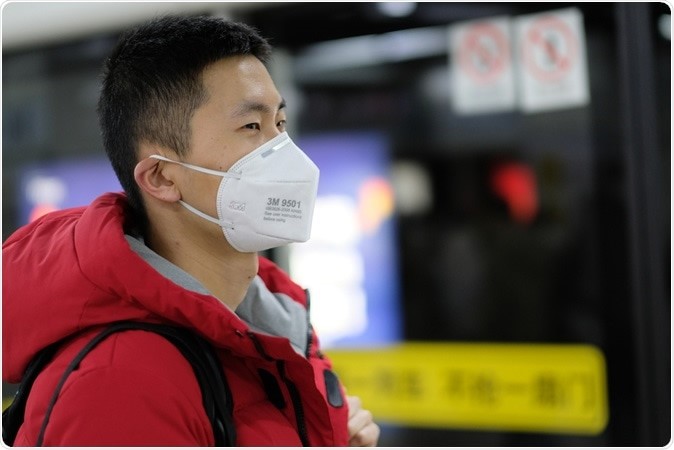
Wearing masks may increase your risk of coronavirus infection, expert says
Editor’s Note: Due to local communities recently foisting mask mandates on their free citizens, we have decided to rerun this very pertinent article.
By Angela Betsaida B. Laguipo, BSN
Panic buying and the hoarding of face masks to protect from the coronavirus disease (COVID-19) may not be a good idea, says a health expert. It puts you at an increased risk of contracting the virus.
Dr. Jenny Harries, England’s deputy chief medical officer, has warned that it was not a good idea for the public to wear facemasks as the virus can get trapped in the material and causes infection when the wearer breathes in.
Jenny Harries, the UK’s deputy chief medical officer, said masks could “actually trap the virus”. Image Credit: Robert Wei / Shutterstock
For the public, they should not wear facemasks unless they are sick, and if a healthcare worker advised them.
“For the average member of the public walking down a street, it is not a good idea,” Dr. Harries said.
“What tends to happen is people will have one mask. They won’t wear it all the time, they will take it off when they get home, they will put it down on a surface they haven’t cleaned,” she added.
Further, she added that behavioral issues could adversely put themselves at more risk of getting the infection. For instance, people go out and don’t wash their hands, they touch parts of the mask or their face, and they get infected.
Masks are recommended for those showing symptoms of a disease, if they are sick, or they have tested positive for COVID-19 since these are designed to prevent the virus from coming out.
When the outbreak started in China, the epicenter of the viral infection, the demand for face masks surpassed 200 million in a day in January, straining the supply. To compensate for the increased demand, many manufacturers had to cancel the leave of staff and increase wages to ramp up the production.
COVID-19 has led to decreasing supplies of personal protective equipment across the globe, leaving health workers and front liners without protection against the virus when they take care of infected patients. The World Health Organization (WHO) urged people not to hoard and buy masks by bulk to help distribute the resources properly.
When to wear a mask?
The World Health Organization (WHO) recommends that people should only wear a face mask or surgical mask if they are taking care of a person with suspected COVID-19 and if they are sick themselves.
Wearing masks is effective only when used in combination with regular and proper handwashing with soap and water or an alcohol-based hand rub. Further, those who wear masks should know how to use and dispose of them properly.
The Center for Health Protection issued a statement saying that a face mask provides a physical barrier to fluids and large-particle droplets. It added that when used properly, these masks prevent infections transmitted by respiratory droplets. However, it should only be used when people have a respiratory infection, when taking care of an infected patient, or when visiting clinics or hospitals during a pandemic or the peak season of flu.
It is crucial to choose a mask with the appropriate size for children and adults. Before using a mask, wash the hands properly, and the mask should fit snugly over the face. The recommended mask, if needed, is the one with a three-layer design, which includes an outer layer that repels water, a middle layer that becomes a barrier for pathogens, and the inner layer that absorbs moisture. Other face masks without these layers are not recommended.
Coronavirus global toll
The COVID-19 outbreak started in a seafood market in Wuhan City, Hubei Province, in China in December 2019. Within nearly three months of the epidemic, the death toll ballooned to about 6,065, and the number of confirmed cases has reached more than 162,687.
China has experienced the most number of infections, with more than 81,000 confirmed cases. In February, the virus started to spread to countries outside China, with Italy, Iran, and South Korea facing the most number of infections.
Italy has recorded a death toll of 1,441, while more than 21,000 have been infected. Iran has nearly 14,000 confirmed cases and 724 deaths, while South Korea has more than 8,162 and 75 deaths.
Sources:
- Coronavirus: Face masks could increase risk of infection, medical chief warns – https://www.independent.co.uk/news/health/coronavirus-news-face-masks-increase-risk-infection-doctor-jenny-harries-a9396811.html
- World Health Organization (WHO). (2020). Coronavirus disease (COVID-19) advice for the public: When and how to use masks. https://www.who.int/emergencies/diseases/novel-coronavirus-2019/advice-for-public/when-and-how-to-use-masks
- Center for Health Protection (CHP). (2020). Use Mask Properly. https://www.chp.gov.hk/files/pdf/use_mask_properly.pdf
- Coronavirus COVID-19 Global Cases by the Center for Systems Science and Engineering (CSSE) at Johns Hopkins University (JHU) – https://gisanddata.maps.arcgis.com/apps/opsdashboard/index.html#/bda7594740fd40299423467b48e9ecf6
Related Stories
- Does cholesterol play a role in COVID-19?
- Antibodies from llamas may hold cure for novel coronavirus SARS-CoV-2
- Study shows COVID-19 vulnerability is highly dependent on host genetic architecture
From news-medical.net